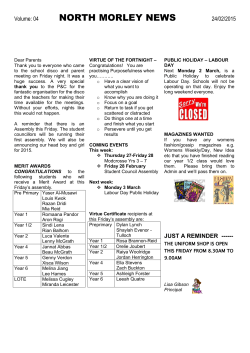
CONCEPTUAL GARDEN EXHIBITORS
2015 RHS HAMPTON COURT PALACE FLOWER SHOW CONCEPTUAL GARDEN EXHIBITORS Please note: This information is subject to change. Full planting lists are available on request from the Shows PR Team. Images are available from PhotoShelter at www.rhs.photoshelter.com. Please contact showspr@rhs.org.uk to gain access. African Vision: Malawi www.africanvision.org.uk/garden Designer(s): Sponsor(s): Contractor: Gabrielle Evans African Vision Malawi Marmalade Jam Landscapes Media Contact Name: Nigel Palmer Media Contact Details: nigel.palmer@africanvision.org.uk / +442082878169 Garden Description The garden is centred on an 'infinity mirror' trick, creating a sensational illusion of fields of maize stretching into the distance. The aim is for the visitor to question the illusion of a field of plenty. The eye plays tricks on us, is what we see the whole story? Food security means not relying on just one crop which can so easily fail. Maize has very few nutrients and relies on chemical fertilizers and pesticides, causing environmental damage. The surrounding gardens show an alternative vision of sustainable agricultural practices which African Vision Malawi are promoting as a means of combating famine and building resilient communities. African Vision Malawi is celebrating their 10th anniversary, with the garden as a focal point for the anniversary. This will be the first time designer Gabrielle Evans has exhibited at an RHS Show. Colour Scheme/Planting The planting theme is 'permaculture', (a sustainable method of agriculture) and there are 4 key areas: The Forest garden, made up of roughly seven layers and focusing on perennial food crops: the canopy, lower canopy, shrub layer, herbaceous layer, groundcovers, rhizosphere (root crops) and a climbing layer (vines). The '3 sisters bed', the three crops benefit from each other. The maize provides a structure for the beans to climb, eliminating the need for poles. The beans provide the nitrogen to the soil that the other plants utilize, and the squash spreads along the ground, helping prevent weeds. The squash leaves also act as a ‘living mulch’, creating a microclimate to retain moisture in the soil mountainous area, where we will display traditional medicinal plants and beneficial flowers Finally, a permaculture display garden, which will showcase different crops and perennials often seen in Malawi, also displaying techniques like woven plant protectors and raised beds built from adobe beds. DialAFlight Synaesthesia Garden www.dialaflight.com Designer(s): Sponsor(s): Contractor: Sarah Wilson DialAFlight Frogheath Landscapes Media Contact Name: Sarah Wilson Media Contact Details: Sarah@galanthusgardening.com / 07834451729 Garden Description Synaesthesia is a neurological phenomenon in which stimulation of one sense leads to automatic, involuntary experiences in a second sense. The garden is contained within a white canvas dome so the visitor can enter a space designed to represent the inside of synaesthete's head. Once inside, the garden will be washed with different coloured lights in response to trigger words that are projected onto the inside of the dome echoing the multi-sensory experiences of a synaesthete. Specially commissioned sculptures and paving materials incorporating materials such as glass and mirror will enhance the lighting effects and the visitors' experiences. This will be designer Sarah Wilson’s first exhibit at an RHS Show. Colour Scheme/Planting All white flowers will be used, along with a profusion of silver and variegated foliage. The planting chosen will maximise the effects of the coloured LED lights that will flood the garden in response to a trigger word. Plants will include a wide range of perennials and annuals with white flowers and variegated shrubs. Equilibrium Designer(s): Sponsor(s): Contractor: John Humphreys and Andy Hyde Hallowed Turf Ltd. Mudlarks Media Contact Name: John Humphreys Media Contact Details: john@johnhumphreyssculpture.com / 01323 766070 Garden Description The tall circular henge of silvered weathered groyne wood acts as a striking contrast to the shingle beach, placid pool and wild flower planting. The garden represents a calm summer’s day when the water is smooth and the beach plants are flowering. This harsh environment is usually in constant attack by the wind, waves and the sun. The balance is constantly shifting and nature shows its tenacity with what grows here. This was made very apparent after the storms of 2014. The henge is a depiction of man's attempt to harness the beach shingle and protect the land from the sea. Colour Scheme/Planting The theme of the planting is beach plants and we are using plants common to this environment at Pevensey Bay - sea kale, valerian – with the aim to promote the use of native plant species in beach gardens along the sea front. The Balaji Temple Garden: A Shallow Crossing www.thedesigncic.co.uk Designer(s): Sponsor(s): Contractor: William Butterworth The Balajii Temple Birmingham The DesignCIC Media Contact Name: William Butterworth Media Contact Details: bill@thedesigncic.co.uk / 02083745208 Garden Description This conceptual design directly reflects and embodies the Balaji Temple in Birmingham’s aims and key messages presenting the merits of spiritual awakening in a compelling and immersive manner. The garden is designed to form a spiritual metaphor which speaks of a devotee’s spiritual journey from the earth to heaven, from mundane to more elevated forms of consciousness in pursuit of ‘darshan’. The title of the garden, 'A Shallow Crossing' is derived from the hindu term Tirtha which refers to 'the inspiration enabling one to cross over from worldly engagement to the side of nirvana'. This message is reflected in the use of a series of evocative elements and symbolic structures throughout the garden. The designer believes the Balaji Temple garden will be set apart from other gardens in two key respects: Its use of digital technology and its avowed spiritual design intention. Conceptual gardens are by their nature at the cutting edge of garden design, however this garden will distinguish itself by taking a step beyond this so called 'edge' into the interactive digital future. The garden will also take a step back into the past and the historic role of gardens as a spiritual enclave within the paradise garden tradition. The Balaji Temple garden has therefore more than one serious message to deliver, however as part of its awareness of garden history it will also aspire to wit and humour with the inclusion of a range of digitally activated 'jeu d'esprit'. This will be designer William Butterworth’s first exhibit for an RHS Show. Colour Scheme/Planting Plants are chosen for their symbolic value and immersive impact. For example, banks of white vertical planting create an enclosed ethereal atmosphere appropriate to a garden designed to form a bridge between heaven and earth. Similarly, white lotus flowers float in small pools, traditionally shown as the seat of Mother Saraswati, the Godess of Moksha. Gallery of Mirrors www.studiospin.it Designer(s): SPIN Sponsor(s): Torsanlorenzo Gruppo; Florovivaistico; Vivai Paradello, Tutor International; Contractor: AD Homes Ltd. Media Contact Name: Niccolò Cau Media Contact Details: spazioperlingegno@gmail.com / 003963700038 Garden Description Mediterranean landscape with its strong contrasts is the focus of this design. The garden is inspired by the sensations caused by the different contrasts, typical of the Mediterranean landscape. A silent artificial geometric object is immersed in a shapeless botanical mass. This mass, consisting of dishevelled shrubs coloured hundreds of shades of yellow, contrasts with the ‘inside’ garden of the mysterious object: a gallery of sculptural succulents of a single essence. Visitors will see their "portraits" reflected in the "Gallery of Mirrors" mixed with those of zoomorphic Opuntia, the sharper contrast but also the most ambiguous. To mark the conceptual character and careful botanical research, a circular base of flowery meadow makes the composition suspended from the context. Colour Scheme/Planting For the walls of the Gallery, the colours of the plants are used for surfaces, in extension, and not punctually: outside, above a base of flowery white-pink meadow (Phyla nodiflora), different species of shrubs offer many shades of yellow (e.g. Spartium junceum), while in the Gallery stands the "no colour" green of the succulents (Opuntia engelmannii). The SMART Vision Garden: Having the vision to see beyond mental illness www.visiongardens.co.uk Designer(s): Sponsor(s): Contractor: Steve Smith St Mary Abbott Rehabilitation and Training Imperial Landscapes Media Contact Name: Steve Smith Media Contact Details: steve@visiongardens.co.uk / 07771623012 Garden Description The garden - like SMART's philosophy - uses a simple idea to dramatic effect and represents the ability to break down the barriers created by boundaries across time, space and thinking. The design uses the concept of the hortus conclusus to illustrate that by taking the time to view the subject of mental health from the right angle that these boundaries can be broken down and an expansive landscape of possibilities opens up. The garden design gives people the opportunity to experience the opening up of hortus conclusus, symbolising the possibilities that emerge when one ‘thinks outside the box’. Multiple viewing heights represent an attempt to break down the barriers of accessibility and the radiating benefit that can be achieved when a good idea is put into action is represented through the inclusion of a concentric circle raked gravel garden symbolising the ripple effect of a pebble dropped into water. The garden will use SMARTS garden project run by Steve Smith to engage members wherever possible in the preparation, build and during the show adding to their skill set and involving them with an event that would otherwise be inaccessible to them. Colour Scheme/Planting Planting such as Dicksonia antarctica, Osmunda regalis and Dryopteris erythrosora from the Jurassic and Triassic periods represent the resilience and sustainability of nature across time and the reflection of its image into an infinite future. The planting scheme comes from a palette of plants that existed over 200 million years ago and have survived at least one mass extinction and vast climatic variations suggests that nature is more robust than it is given credit and challenges the boundaries of fear that surround our fragile planet. Additional ‘Wild Card’ Garden, Separate from the ‘Senses’ Theme: Ready… Aim… Flower! Designer(s): Contractor: Simon Webster Burnham Landscaping Media Contact Name: Simon Webster Media Contact Details: swgardenhero@gmail.com / 07595 042180 Garden Description Inspired by the reclaiming of local city centre wasteland, ‘Ready…Aim…Flower!’ shows how destructive influence gives way to regeneration; how plants colonise and thrive over time, reclaiming the landscape through a process of succession. With theatre and drama at the fore, ‘Ready…Aim…Flower!’ uses a dominant sculpture of a gun as a metaphor for destructive influence, pointing towards a seating area where relaxation and reflection are possible. The journey through the garden takes you toward recovery; however, the opportunity to relax should not be taken for granted, as a reminder of how this process began is always with you. The garden serves as both a positive and negative reminder; firstly that although an environment can recover, its recovery cannot be taken for granted. Secondly, that despite destructive influence, an environment can pave the way for plants to colonise and thrive. Colour Scheme/Planting The further toward the 'relaxation' area, the more colourful the planting will become, with plants such as Digitalis, Buddleja, Centranthus. Closer to the gun, the planting is basic and representative of neglected land, with simple grasses, moss and dandelion.
© Copyright 2025









